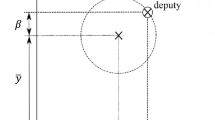Abstract
Space vehicle missions are subject to collisions with space debris. The possibility of catastrophic accidents is confirmed with the constant growth of the launch rates. The mitigation measures include the sending of tug vehicles that seek to capture debris and bring them to regions of atmospheric drag activity. Rendezvous maneuvers require safety operations, considering the risk of collision at the moment of coupling between operational vehicles, in the operations of SpaceClean, among others. The perfect Rendezvous is accomplished with relative speed and position null, but this condition needs to be achieved with sufficient technological precision. In this work, we find this condition and the propulsion technological parameters for simultaneous and minimum time Rendezvous maneuvering, through solutions of a multivariable equation.
Similar content being viewed by others
References
D.J. Kessler, B.G. Cour-Palais, J. Geophys. Res. Space Phys. 83, 2637 (1978).
E. Doornbos, H. Klinkrad, P. Visser, Adv. Space Res. 36, 515 (2005).
B. Zhang, Z. Wang, Y. Zhang, Adv. Space Res. 58, 903 (2016).
J.M. Lafleur, Extension of a simple mathematical model for orbital debris proliferation and mitigation (2011).
A.D.C. Jesus, R.R. Sousa, E.V. Neto, J. Phys.: Conf. Ser. 641, 012021 (2015).
H. Klinkrad, Space debris: models and risk analysis (Springer Praxis, Berlin, Heidelberg, 2006).
A. Rossi, G.B. Valsecchi, Cel. Mech. Dyn. Astron. 95, 345 (2006).
N.N. Smirnov, Space debris hazard evaluation and mitigation (Taylor & Francis, London, New York, 2002).
A.F.B.A. Prado, G. Felipe, SBA Controle Automação 12, 156 (2001).
A.D.C. Jesus, T.N. Teles, Nonlinear Dyn. Syst. Theory 7, 279 (2007).
G.W. Hill, Am. J. Math. 1, 5 (1878).
A.D.C. Jesus, R.S. Ribeiro, A. Rossi, V.E. Neto, Math. Probl. Eng. 2012, 126521 (2012).
Author information
Authors and Affiliations
Corresponding author
Additional information
Publisher’s Note
The EPJ Publishers remain neutral with regard to jurisdictional claims in published maps and institutional affiliations.
Rights and permissions
About this article
Cite this article
de Jesus, A.D.C., Santos, G.L.F. Reducing the risk of space debris collisions using conditions or performance simultaneous operation in minimum time. Eur. Phys. J. Spec. Top. 229, 1419–1427 (2020). https://doi.org/10.1140/epjst/e2020-900194-x
Received:
Revised:
Published:
Issue Date:
DOI: https://doi.org/10.1140/epjst/e2020-900194-x




